Abstract
A review of heteroditopic interlocked molecules and their application as receptors for simple inorganic ion pair species. The review details the design and ion recognition properties of the rotaxane and catenane receptors, as well as highlighting some of the experimental challenges; hence, it provides insight into possible future avenues of research in this youthful field.
1. Introduction
The binding of ionic species by molecular receptors has been a cornerstone of supramolecular chemistry [,,]. While still being added to, the supramolecular chemical literature possesses vast quantities of work regarding the binding of cationic [] and anionic [,,] species. In contrast, the field of ion pair recognition [,,,] is much less developed, yet any ion will have associated with it (somewhere) a counter-ion, and it has been recognized that the binding of specific ion pairs may be desirable for applications (beyond simple binding or sensing) such as salt extraction and solubilization [,,,,,,,] or symportic transmembrane ion transportation [,].
Receptors capable of simultaneously binding a cation and an anion can be classified as either contact ion pair or separated ion pair receptors. Separated ion pair receptors may be further categorized as either host-separated or solvent-separated. The binding of one ion typically increases the binding affinity of the receptor for the counter-ion—positive allostery—due to the favourable electrostatic interaction between oppositely charged ions. However, there are examples of negative allostery, arising from conformational changes induced by the first binding event that have a detrimental impact on the binding site for the counter-ion. The study of ion pair recognition is complicated (in comparison to either cation or anion recognition) due to the number of equilibria that may exist in an ion pair binding system. The receptor may bind either the anion or cation alone, the desired ion pair binding may occur, or the ion pair may precipitate as the extended ionic lattice [].
It is now well-established that the three-dimensional cavities of mechanically interlocked molecules [,] such as rotaxanes (molecules consisting of macrocyclic ring(s) trapped on a stoppered axle []) and catenanes (interlocked macrocyclic rings []) may act as binding sites for ionic guests [,,,]. In fact, Sauvage reported on the binding affinities for a range of metal cations in his seminal passive metal templated [2]catenane [], and several research groups have since demonstrated the binding of cations by other rotaxanes and catenanes [,,,,,,,,,,]. Numerous anion binding examples have been reported by Beer [,,,,,,,,,,,,,,,] and others [,,,], while Leigh’s group has demonstrated anion binding by metalated molecular knots [,]. It is notable that the active metal template synthetic strategy (where a metal cation templates self-assembly and mediates the covalent bond formation step leading to capture of the interlocked structure [,]) has been used in the preparation of several examples of MIMs capable of cation or anion binding [,,,].
In contrast to the binding of cations or anions by interlocked molecules, the simultaneous binding of a cation and an anion by heteroditopic interlocked molecules is very much an emerging area of research interest. This review charts progress in this field from its roots some 20 years ago in the labs of Bradley D. Smith, to the most recent achievements, before concluding with thoughts on future avenues of research. Examples are limited to heteroditopic interlocked molecules that are capable (at least in principle) of the binding of a cation and an anion.
2. Early Examples of Rotaxanes Incorporating Heteroditopic Macrocycles
In 2000, Smith and co-workers reported [] the preparation of rotaxane 1 utilizing a heteroditopic isophthalamide/crown ether macrobicycle, where installation of the axle component was achieved by application of Vögtle’s phenoxide hydrogen bond templation methodology [] (Figure 1). In Smith’s preliminary communication, the freezing out of a single co-conformation of rotaxane 1 in DMSO-d6 was achieved by addition of KPF6 with binding of the K+ cation in the crown ether.
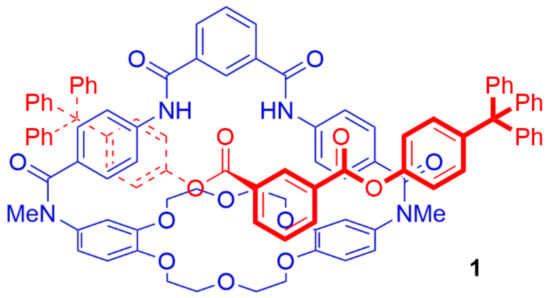
Figure 1.
Structure of Smith’s original rotaxane 1 containing a heteroditopic isophthalamide/crown ether macrobicycle in the absence of coordinating ions.
In a subsequent full paper, comparisons were made with rotaxanes consisting of isomeric macrobicycles and axles []. Yields of 3–20% with respect to rotaxane formation were achieved when the reaction was run in a polar solvent system of 5:1 THF/DMF, used to avoid precipitation of the macrobicycle/KCl complex. At room temperature, in polar solvents (e.g., DMSO-d6 or acetone-d6), the 1H NMR spectra of the rotaxanes are broad. Titration of TBACl in DMSO-d6/CD3CN (3:1), in the absence and presence of KBPh4, revealed that the chloride ion is bound within a pocket arising from the macrocycle and axle components, the anion being held in place by hydrogen bonds to the N-H amide groups (Figure 2).

Figure 2.
Proposed binding mode of KCl by Smith’s original rotaxane 1.
In the absence of K+, rotaxane 1 binds chloride six times more strongly than the free macrobicycle (K = 300 M−1 vs. 50 M−1). The authors attribute this observation to the inability of a DMSO molecule to compete with chloride in the sterically more constricted rotaxane cavity. Notably, the presence of 1 equivalent K+ led to no variation in chloride ion affinity for rotaxane 1 (unlike for the free macrobicycle where a positive allosteric effect is observed). This is likely to be due to the axle of rotaxane 1 insulating the through-space attractive electrostatic interaction between the bound K+ and Cl−.
Orozco and Luque undertook a molecular dynamics study of the co-conformational behaviour of rotaxane 1 []. In chloroform, rotaxane 1 was calculated to exist in a mixture of co-conformations including some with hydrogen bonds between the axle C=O and macrocycle N-H groups. In contrast, in DMSO, no hydrogen bonded co-conformations were identifiable, presumably due to the macrocycle N-H groups hydrogen bonding to the DMSO solvent molecules. The modelling revealed that the axle experiences notable changes in anisotropic shielding, which is consistent with the broad 1H NMR signals observed experimentally. Adding a Na+ cation, bound within the crown ether, reduces co-conformational flexibility by interactions of the axle with the cation.
We note that a related rotaxane 2 was subsequently prepared by Moustrou and co-workers [] (Figure 3). The researchers included binaphthopyrans in the stoppers of the rotaxane. The photochemical properties of rotaxane 2 (when dissolved in acetonitrile) are perturbed by the addition of Na+; there is an increase in the absorbance of the open form of the chromene chromophore, while there is a decrease in absorbance of the closed form.
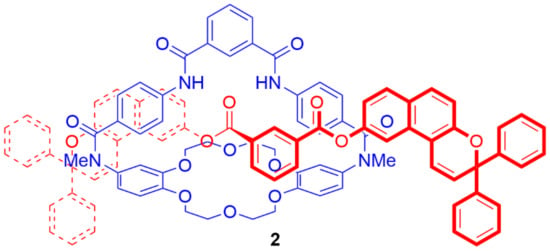
Figure 3.
Structure of Moustrou’s rotaxane 2 with chromene stoppers in their closed form.
Smith’s group also reported the preparation of rotaxane 3, where the axle possessed an acetal linkage (Figure 4a) []. The yield of the formation was 15% (notably no rotaxane was formed when using the 2,6-pyridyl analogue of the macrobicycle). In DMSO-d6, in the presence of 1 equivalent of NaBF4, there was no observed enhancement in chloride binding at the isophthalamide (Kno cation = Kwith Na+ = 2 M−1) and only modest enhancement with KBF4 (Kwith K+ = 5 M−1). It is notable that this mirrors trends with the free macrobicycle (Kno cation = 5 M−1, Kwith Na+ = 5 M−1, Kwith K+ = 15 M−1), and the lack of a significant positive allosteric effect probably reflects the larger distance between the isophthlamide and crown ether in the macrobicycle in comparison to that in original rotaxane 1. Rotaxane 4 with a longer axle was also prepared (Figure 4b). In DMSO-d6, the lipophilic alkyl portion of the axle resides within the macrocycle cavity. However, the addition of perchlorate salts of a range of cations (Na+, K+, Ba2+, Ag+) does not lead to movement of the axle.

Figure 4.
Structures of Smith’s acetal axle rotaxanes 3 (a) and 4 (b).
3. Ion-Induced Motion in Rotaxanes and Catenanes Incorporating Heteroditopic Macrocycles
After a gap of almost a decade from the studies above, Beer’s research group reported on the synthesis of several interlocked molecules that incorporated a heteroditopic calix[4]diquinone-isophthalamide macrobicycle and subsequent studies of the ion-induced motion of the interlocked components. While no ion pair binding studies were detailed, we have chosen to include these examples for completeness.
In 2011, Leontiev, Beer and co-workers reported on the preparation of a rotaxane 5 containing a calix[4]diquinone-isophthalamide macrobicycle and a 3,5-bis-amide methyl pyridinium axle component, prepared by chloride anion templation and copper-catalyzed alkyne-azide cycloaddition (CuAAC) “click” stoppering (Figure 5) []. The hexafluorophosphate salt was shown to bind cations in dichloromethane–acetonitrile system mixtures (and anions in chloroform/methanol). While no dramatic changes in conformation are observed upon addition of monovalent cations such as Na+ and K+, the addition of Ba2+ displaces the pyridinium unit of the axle, tentatively indicating coordination of the triazole to the alkaline earth metal cation bound by the calix[4]diquinone. This process can be reversed by the addition of (TBA)2SO4 to precipitate out insoluble BaSO4. Related catenane systems were prepared by Grubbs’ catalyzed ring closing metathesis of methyl and benzyl pyridinium threads functionalized with terminal vinyl groups []. As the hexafluorophosphate salt, binding of Ba2+ leads to co-conformational partial rotation of the pyridinium ring, reversible upon the addition of (TBA)2SO4.
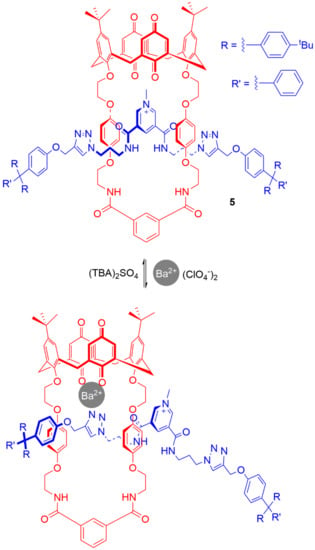
Figure 5.
Barium cation-induced motion in Leontiev and Beer’s calix[4]diquinone–isophthalamide macrobicycle rotaxane 5.
Contemporaneously, Hancock and Beer reported rotaxane 6 containing the same calix[4]diquinone macrobicycle, and a pyridine-N-oxide axle (Figure 6) []. Metal ions could act as templates for rotaxane formation (yields: Na+ 50%, Ba2+ 28%, no metal ion 10%). The resulting rotaxanes were isolated metal ion free, but the addition of Ba2+ led to pirouetting of the axle so that the pyridine-N-oxide axle coordinates to the Ba2+ bound at the diquinone (instead of hydrogen bonding to the isophthalamide cleft), a process once again reversible by addition of (TBA)2SO4.
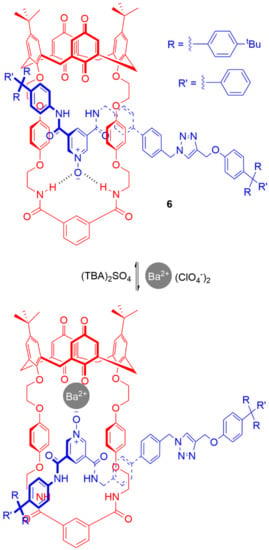
Figure 6.
Hancock and Beer’s pirouetting calix [4]diquinone–isophthalamide macrobicycle rotaxane 6.
4. Further Examples of Heteroditopic Rotaxanes Binding Ion Pairs
In 2014, Knighton and Beer reported calix[4]diquinone rotaxane 7 with a pyridine-N-oxide axle and showed that this was capable of binding ion pairs cooperatively in 4:1 CDCl3/CD3OD (Figure 7) []. Very modest cooperative factors are observed for the binding of chloride (1.1) or bromide (1.9) anions in the presence of 1 equivalent of Li+, while in the presence of Na+ (Cl− 15.1, Br− 10.6) or K+ (Cl− 9.5, Br− 7.2) there are notable enhancements. The binding of the cation occurs at the diquinone and hence induces the pirouetting of the axle to create a convergent N-H amide hydrogen bonding cavity.
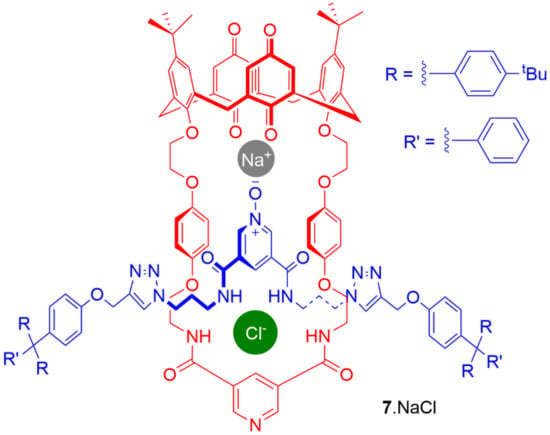
Figure 7.
Knighton and Beer’s rotaxane 7 exhibiting axle separated cooperative ion pair binding.
Beer’s group followed this work by synthesizing rotaxanes that bind d-block metal cations (Figure 8) []. Rotaxanes 8–10 were prepared by a Cu2+ directed passive metal template strategy: an isophthalamide/tris-amine macrocycle was pre-metallated with the copper cation, before interlocked axle formation by the stoppering of a coordinating bipyridyl or pyridyl axle precursor. The anion binding sites comprise convergent hydrogen bond donors, or mixed hydrogen bond and C-I halogen bond donor groups. The cation binding site consist of the macrocycle tris-amine with axle bipyridine or pyridyl and carbonyl oxygen groups.
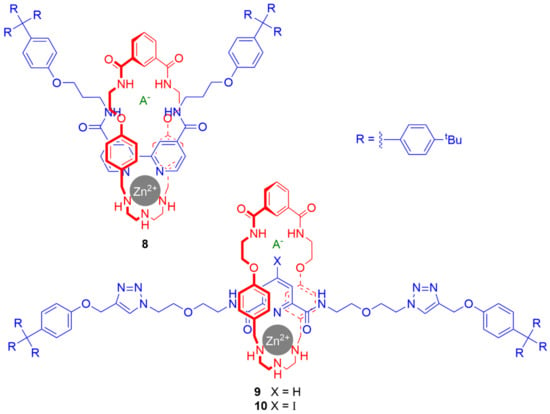
Figure 8.
Beer’s tris-amine macrocycle rotaxanes 8–10 exhibiting axle separated cooperative ion pair binding.
1H NMR titration experiments revealed cooperative binding of halide and nitrate anions in the presence of a co-bound Zn2+ cation in 1:1 CDCl3/CD3OD. For the bipyridyl axle rotaxane 8, in the absence of Zn2+, no binding of halide anions is observed; this is attributed to a lack of preorganization and electrostatic effects. For the Zn2+ metallated pyridyl axle rotaxanes, there is little difference in the anion association constants between the all-hydrogen-bonding 9 and the halogen-bonding-containing 10 (e.g., KCl− = 500 M−1 and 535 M−1, KBr− = 925 M−1 and 1080 M−1, respectively, in 45:45:10 CDCl3/CD3OD/D2O).
Ghosh and co-workers have extensively investigated heteroditopic rotaxanes based on related tris-acylated nitrogen macrocycles. For example, for tris-acylated rotaxane 11, rotameric behaviour of the acetyl groups in 9:1 CDCl3/CD3CN solution may be impeded upon addition of Na+ (or Li+) cation (Figure 9) []. The addition of 18-crown-6 (or 12-crown-4) reveals the regeneration of the dynamic behaviour of the tertiary amide groups. Adapting this rotaxane structure to include fluorophores allows for study using UV–vis [] and fluorescence [] spectroscopies, to generate cation sensory systems. More recently, inclusion of NDI in related rotaxane (and catenane) structures, allowed for interaction with fluoride or cyanide to be detected by absorption and emission []. To emphasize, none of these studies focused on the binding of ion pairs.
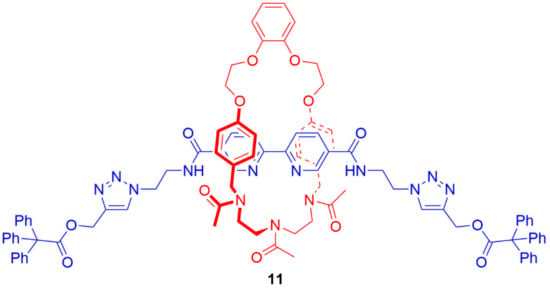
Figure 9.
Ghosh’s tris-acylated rotaxane 11 lockable using alkali metal cations.
Very recently, Beer and co-workers have reported on lithium halide recognition (Figure 10) []. A family of related rotaxanes 12–14 were prepared by CuAAC “click” active metal template methodology, including one example (14) which has a fully halogen bonding anion pocket. Coordination of Li+ by the macrocyclic pyridyl and the axle triazole, polarizes and preorganizes the potential anion binding donor groups. LiBr is bound more strongly than LiI in CD3CN/CDCl3 solvent mixtures for all three rotaxanes prepared, with the all-halogen bonding rotaxane binding bromide strongest (Kwith 1 eq Li+ > 104 M−1 in 3:7 CD3CN/CDCl3).
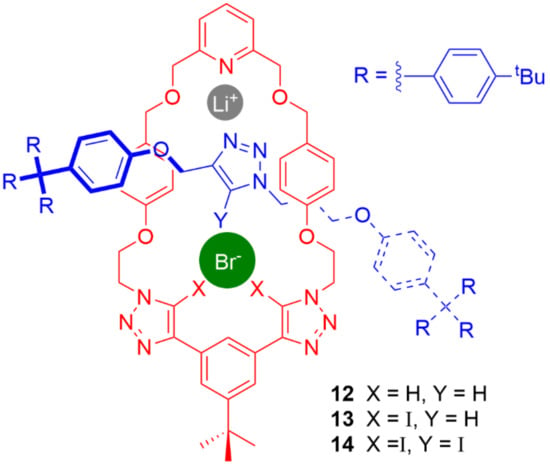
Figure 10.
Beer’s active metal templated rotaxanes 12–14 capable of selective lithium bromide recognition.
Previously, Goldup and Joliffe had reported an active metal templated rotaxane 15 that contained a urea within the axle component (Figure 11) []. However, when neutral, rotaxane 15 was not able to bind anions as anticipated at the urea. Single crystal X-ray crystallography revealed the urea N-H hydrogen bonding to the bipyridyl nitrogens of the macrocyclic component. The addition of a proton (by use of HBF4) allows for the binding of a range of anions in 1:1 CDCl3/CD3CN by disruption of these intercomponent hydrogen bonds. The authors reported rotaxane 15 as an ion pair binding system, i.e., treating the proton as a cation.
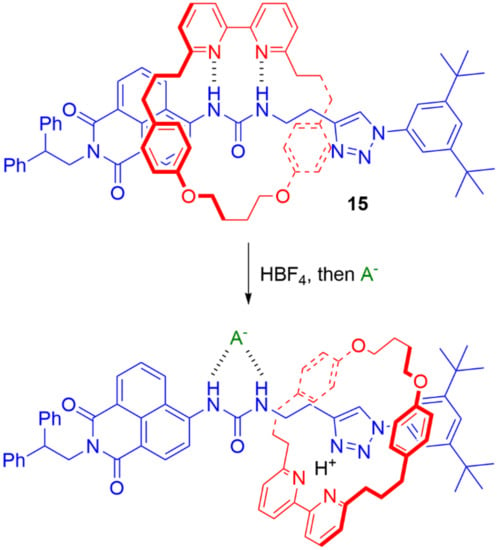
Figure 11.
Revealing of anion binding site by proton induced shuttling in Goldup and Joliffe’s urea containing active template metallated rotaxane 15.
Ballester and co-workers have demonstrated ion pair binding by a pyridine-N-oxide axle/bis(calix[4]pyrrole) macrocycle-containing rotaxane 16 (Figure 12) []. Intriguingly, in chloroform, rotaxane 16 bound both anions and their tetraalkylammonium counter-cations, and when an excess of salt was added, the 1:1 complex of rotaxane and salt converted to a 1:2 complex. Very recently the researchers have studied the binding behaviour in more depth by variation of solvent (specifically acetone and chloroform/methanol mixtures) and have found in these more competitive solvents that the principal binding event is anion binding [].
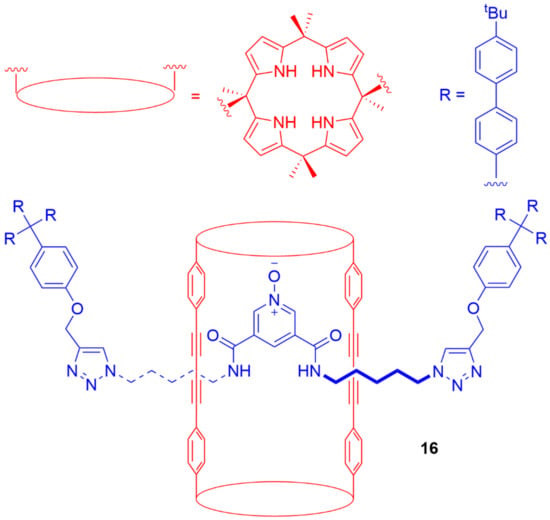
Figure 12.
Ballester’s pyridine-N-oxide rotaxane 16 using a bis(calix[4]pyrrole) macrocycle.
5. Heteroditopic Catenanes Binding Ion Pairs
To date, very few demonstrations of catenanes binding ion pairs have been reported. In 2011, while working in Beer’s laboratories, one of us (N.H.E.), reported the crystal structure of a neutral catenane 17, serendipitously binding a sodium cation/chloride anion ion pair. The chloride anion is held in a convergent amide hydrogen bonding cleft, while the alkali metal cation is coordinated between the pyridyl nitrogen of one macrocycle and two glycol oxygen atoms of the other ring (Figure 13) [].
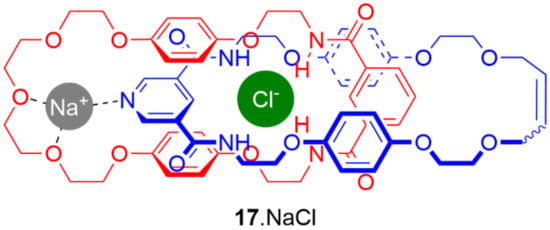
Figure 13.
Evans and Beer’s neutral pyridyl catenane 17 that serendipitously exhibited ion pair binding in the solid state.
More recently, Knighton and Beer have reported on another crystal structure of a catenane simultaneously binding a sodium cation and chloride anion (Figure 14) []. Catenane 18 was prepared by reacting the bis(pentafluorophenyl) ester of 3,5-pyridinedicarboxylic-1-oxide acid with a bis-amine in the presence of a sodium-metalated methyl pyridinium calix[4]diquinone macrobicycle. Catenane 18 was isolated in a modest 7% yield, with a crystal structure revealing chloride binding within a convergent amide hydrogen bonding pocket, with the sodium cation coordinated by the calix[4]diquinone and pyridine-N-oxide.
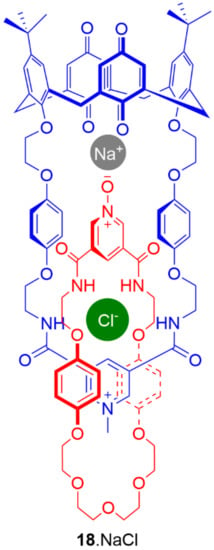
Figure 14.
Knighton and Beer’s ion pair catenane 18 exhibiting separated ion pair binding in the solid state.
During the peer review of this manuscript, Beer and co-workers published the first detailed report on solution phase ion pair recognition studies with catenanes (Figure 15) []. Catenanes 19 and 20 were prepared using an adaptation of Chiu’s alkali metal templation methodology [,], clipping shut Na+ templated pseudorotaxanes by use of the CuAAC “click” reaction. Both catenanes, therefore, possess a single multidentate alkali metal cation binding site arising from the glycol sections of the interlocked rings and—in theory—two bidentate halogen bond donor binding sites for halide anions. However, based on quantitative 1H NMR titrations carried out in 1:1 CDCl3/CD3CN, catenane 20 only exhibits enhanced 1:1 binding of bromide and iodide in the presence of 1 equivalent of Na+ or K+ cation. Catenane 19 demonstrated similar anion binding behaviour with 1 equivalent of K+, but with 1 equivalent of Na+ the binding of a second equivalent of halide anion could be detected. Based on crystallographic evidence, this observation was attributed to the Na+ cation being coordinatively unsaturated when bound by the shorter glycol chains of 19. The first equivalent of anion, therefore, coordinates strongly to the cation, before a second equivalent of anion halogen bonds to one of the two bis-iodotriazoles. In addition to these studies, the researchers demonstrated both catenanes were able to extract solid halide salts (NaBr and NaI for 19 and KBr and KI for 20) into chloroform.

Figure 15.
Beer and co-workers’ alkali metal cation templated catenanes 19 and 20, capable of solution phase binding, and extraction of, ion pairs.
6. Conclusions
It has been shown that, in solution and the solid state, interlocked molecules are capable of binding ion pairs. However, studies have been surprisingly limited considering the number of cation and anion binding interlocked molecules that have been reported over the same period. We attribute this to the synthetic challenge of preparing interlocked molecules capable of binding more than one ion, as well as the perennial ion pair recognition problem of salt precipitation during titration studies. There has been a strong (if not exclusive) focus on alkali metal halide ion pairs, but we anticipate that a wider range of ion pair guests will be targeted in future investigations, including enantioselective ion pair recognition (which, in turn, opens up the possibility of ion pair induced asymmetric catalysis). We also predict that attention will turn to deploying interlocked molecular hosts for ion pairs in other applications, such as sensing and transportation, in our own laboratories and elsewhere.
Author Contributions
Conceptualization, N.H.E.; investigation, S.J.N., S.R.B. and N.H.E.; writing—original draft preparation, S.J.N. and S.R.B.; writing—review and editing, N.H.E.; supervision, N.H.E.; project administration, N.H.E.; funding acquisition, N.H.E. All authors have read and agreed to the published version of the manuscript.
Funding
S.R.B. acknowledges Ph.D. funding from EPSRC DTP (EP/T518037/1) and a Sydney Andrew Scholarship from the Society of Chemical Industries. N.H.E. expresses his appreciation to Lancaster University (Faculty of Science & Technology Research Grant), the Joy Welch Educational Charitable Trust and the Royal Society (RG140399) for funding of investigations into new heteroditopic rotaxanes.
Data Availability Statement
Not applicable—as this work is a literature review, there is no new data underpinning this publication.
Conflicts of Interest
The authors declare no conflict of interest.
References
- Lehn, J.-M. Supramolecular chemistry—Scope and perspectives molecules, supermolecules, and molecular devices (Nobel Lecture). Angew. Chem. Int. Ed. Engl. 1988, 27, 89–112. [Google Scholar]
- Cram, D.J. The design of molecular hosts, guests, and their complexes (Nobel lecture). Angew. Chem. Int. Ed. Engl. 1988, 27, 1009–1020. [Google Scholar]
- Pedersen, C.J. The discovery of crown ethers (Noble Lecture). Angew. Chem. Int. Ed. Engl. 1988, 27, 1021–1027. [Google Scholar]
- Izatt, R.M.; Bradshaw, J.S.; Nielsen, S.A.; Lamb, J.D.; Christensen, J.J. Thermodynamic and kinetic data for cation-macrocycle interaction. Chem. Rev. 1985, 85, 271–339. [Google Scholar]
- Sessler, J.L.; Gale, P.A.; Cho, W.-S. Anion Receptor Chemistry; Royal Society of Chemistry: London, UK, 2006. [Google Scholar]
- Evans, N.H.; Beer, P.D. Advances in anion supramolecular chemistry: From recognition to chemical applications. Angew. Chem. Int. Ed. 2014, 53, 11716–11754. [Google Scholar]
- Busschaert, N.; Caltagirone, C.; Van Rossom, W.; Gale, P.A. Applications of supramolecular anion recognition. Chem. Rev. 2015, 115, 8038–8155. [Google Scholar]
- Kim, S.K.; Sessler, J.L. Ion pair receptors. Chem. Soc. Rev. 2010, 39, 3784–3809. [Google Scholar]
- McConnell, A.J.; Beer, P.D. Heteroditopic receptors for ion-pair recognition. Angew. Chem. Int. Ed. 2012, 51, 5052–5061. [Google Scholar]
- He, Q.; Vargas-Zúñiga, G.I.; Kim, S.H.; Kim, S.K.; Sessler, J.L. Macrocycles as ion pair receptors. Chem. Rev. 2019, 119, 9753–9835. [Google Scholar]
- McConnell, A.J.; Docker, A.; Beer, P.D. From Heteroditopic to Multitopic Receptors for Ion-Pair Recognition: Advances in Receptor Design and Applications. ChemPlusChem 2020, 85, 1824–1841. [Google Scholar]
- Scheerder, J.; van Duynhoven, J.P.M.; Engbersen, J.F.J.; Reinhoudt, D.N. Solubilization of NaX salts in chloroform by bifunctional receptors. Angew. Chem. Int. Ed. Engl. 1996, 35, 1090–1093. [Google Scholar]
- Beer, P.D.; Hopkins, P.K.; McKinney, J.D. Cooperative halide, perrhenate anion-sodium cation binding and pertechnetate extraction and transport by a novel tripodal tris (amido benzo-15-crown-5) ligand. Chem. Commun. 1999, 13, 1253–1254. [Google Scholar]
- Galbraith, S.G.; Plieger, P.G.; Tasker, P.A. Cooperative sulfate binding by metal salt extractants containing 3-dialkylaminomethylsalicylaldimine units. Chem. Commun. 2002, 22, 2662–2663. [Google Scholar]
- Webber, P.R.A.; Beer, P.D. Ion-pair recognition by a ditopic calix[4] semitube receptor. Dalton Trans. 2003, 11, 2249–2252. [Google Scholar]
- Aydogan, A.; Coady, D.J.; Kim, S.K.; Akar, A.; Bielawski, C.W.; Marquez, M.; Sessler, J.L. Poly(methyl methacrylate)s with pendant calixpyrroles and crown ethers: Polymeric extractants for potassium halides. Angew. Chem. Int. Ed. 2008, 47, 9648–9652. [Google Scholar]
- Zakrzewski, M.; Kwietniewska, N.; Walczak, W.; Piątek, P. A non-multimacrocyclic heteroditopic receptor that cooperatively binds and effectively extracts KAcO salt. Chem. Commun. 2018, 54, 7018–7021. [Google Scholar]
- Jagleniec, D.; Dobrzycki, Ł.; Karbarz, M.; Romański, J. Ion-pair induced supramolecular assembly formation for selective extraction and sensing of potassium sulfate. Chem. Sci. 2019, 10, 9542–9547. [Google Scholar]
- Docker, A.; Stevens, J.G.; Beer, P.D. Halogen Bonding Heteroditopic Materials for Cooperative Sodium Iodide Binding and Extraction. Chem. Eur. J. 2021, 27, 14600–14604. [Google Scholar]
- Koulov, A.V.; Mahoney, J.M.; Smith, B.D. Facilitated transport of sodium or potassium chloride across vesicle membranes using a ditopic salt-binding macrobicycle. Org. Biomol. Chem. 2003, 1, 27–29. [Google Scholar]
- Lee, J.H.; Lee, J.H.; Choi, Y.R.; Kang, P.; Choi, M.-G.; Jeong, K.-S. Synthetic K+/Cl−-selective symporter across a phospholipid membrane. J. Org. Chem. 2014, 79, 6403–6409. [Google Scholar]
- Roelens, S.; Vacca, A.; Francesconi, O.; Venturi, C. Ion-Pair Binding: Is Binding Both Binding Better? Chem. Eur. J. 2009, 15, 8296–8302. [Google Scholar]
- Bruns, C.J.; Stoddart, J.F. The Nature of the Mechanical Bond: From Molecules to Machines; John Wiley & Sons: Hoboken, NJ, USA, 2017. [Google Scholar]
- Mena-Hernando, S.; Pérez, E.M. Mechanically interlocked materials. Rotaxanes and catenanes beyond the small molecule. Chem. Soc. Rev. 2019, 48, 5016–5032. [Google Scholar]
- Xue, M.; Yang, Y.; Chi, X.; Yan, X.; Huang, F. Development of Pseudorotaxanes and Rotaxanes: From synthesis to stimuli-responsive motions to applications. Chem. Rev. 2015, 115, 7398–7501. [Google Scholar]
- Gil-Ramírez, G.; Leigh, D.A.; Stephans, A.J. Catenanes: Fifty years of molecular links. Angew. Chem. Int. Ed. 2015, 54, 6110–6150. [Google Scholar]
- Langton, M.J.; Beer, P.D. Rotaxane and catenane host structures for sensing charged guest species. Acc. Chem. Res. 2014, 47, 1935–1949. [Google Scholar]
- Lewis, J.E.M.; Beer, P.D.; Loeb, S.J.; Goldup, S.M. Metal ions in the synthesis of interlocked molecules and materials. Chem. Soc. Rev. 2017, 46, 2577–2591. [Google Scholar]
- Bąk, K.M.; Porfyrakis, K.; Davis, J.J.; Beer, P.D. Exploiting the mechanical bond for molecular recognition and sensing of charged species. Mater. Chem. Front. 2020, 4, 1052–1073. [Google Scholar]
- Tay, H.M.; Beer, P.D. Optical sensing of anions by macrocyclic and interlocked hosts. Org. Biomol. Chem. 2021, 19, 4652–4677. [Google Scholar]
- Dietrich-Buchecker, C.; Sauvage, J.-P.; Kern, J.-M. Synthesis and electrochemical studies of catenates: Stabilization of low oxidation states by interlocked macrocyclic ligands. J. Am. Chem. Soc. 1989, 111, 7791–7800. [Google Scholar]
- Zhu, S.S.; Carroll, P.J.; Swager, T.M. Conducting polymetallorotaxanes: A supramolecular approach to transition metal ion sensors. J. Am. Chem. Soc. 1996, 118, 8713–8714. [Google Scholar]
- Zhu, S.S.; Swager, T.M. Conducting polymetallorotaxanes: Metal ion mediated enhancements in conductivity and charge localization. J. Am. Chem. Soc. 1997, 119, 12568–12577. [Google Scholar]
- Hiratani, K.; Kaneyana, M.; Nagawa, Y.; Koyama, E.; Kanesato, M. Synthesis of [1]rotaxane via covalent bond formation and its unique fluorescent response by energy transfer in the presence of lithium ion. J. Am. Chem. Soc. 2004, 126, 13568–13569. [Google Scholar]
- Nagawa, Y.; Suga, J.; Hiratani, K.; Koyama, E.; Kanesato, M. [3]Rotaxane synthesized via covalent bond formation can recognize cations forming a sandwich structure. Chem. Commun. 2005, 6, 749–751. [Google Scholar]
- Zhou, W.; Li, J.; He, X.; Li, C.; Lv, J.; Li, Y.; Wang, S.; Liu, H.; Zhu, D. A molecular shuttle for driving a multilevel fluorescence switch. Chem. Eur. J. 2008, 14, 754–763. [Google Scholar]
- Baggi, G.; Loeb, S.J. Rotationally Active Ligands: Dialing-Up the Co-conformations of a [2]Rotaxane for Metal Ion Binding. Angew. Chem. Int. Ed. 2016, 55, 12533–12537. [Google Scholar]
- Baggi, G.; Loeb, S.J. Rotationally Active Ligands: Dialing-Up Multiple Interlocked Co-Conformations for Silver (I) Coordination. Chem. Eur. J. 2017, 23, 14163–14166. [Google Scholar]
- Denis, M.; Pancholi, J.; Jobe, K.; Watkinson, M.; Goldup, S.M. Chelating rotaxane ligands as fluorescent sensors for metal ions. Angew. Chem. Int. Ed. 2018, 57, 5310–5314. [Google Scholar]
- Nandi, M.; Bej, S.; Ghosh, T.K.; Ghosh, P. A multifunctional catenated host for the efficient binding of Eu3+ and Gd3+. Chem. Commun. 2019, 55, 3085–3088. [Google Scholar]
- Chan, S.-M.; Tang, F.-K.; Kwan, C.-S.; Lam, C.-Y.; Hau, S.C.K.; Leung, K.C.-F. Water-compatible fluorescent [2]rotaxanes for Au3+ detection and bioimaging. Mat. Chem. Front. 2019, 3, 2388–2396. [Google Scholar]
- Colley, N.D.; Nosiglia, M.A.; Li, L.; Amir, F.; Chang, C.; Greene, A.F.; Fisher, J.M.; Li, R.; Li, X.; Barnes, J.C. One-Pot Synthesis of a Linear [4]Catenate Using Orthogonal Metal Templation and Ring-Closing Metathesis. Inorg. Chem. 2020, 59, 10450–10460. [Google Scholar]
- Wisner, J.A.; Beer, P.D.; Drew, M.G.B.; Sambrook, M.R. Anion-templated rotaxane formation. J. Am. Chem. Soc. 2002, 124, 12469–12476. [Google Scholar]
- Sambrook, M.R.; Beer, P.D.; Wisner, J.A.; Paul, R.L.; Cowley, A.R. Anion-templated assembly of a [2]catenane. J. Am. Chem. Soc. 2004, 126, 15364–15365. [Google Scholar]
- Bayly, S.R.; Gray, T.M.; Chmiełweski, M.J.; Davis, J.J.; Beer, P.D. Anion templated surface assembly of a redox-active sensory rotaxane. Chem. Commun. 2007, 22, 2234–2236. [Google Scholar]
- Kilah, N.L.; Wise, M.D.; Serpell, C.J.; Thompson, A.L.; White, N.G.; Christensen, K.E.; Beer, P.D. Enhancement of anion recognition exhibited by a halogen-bonding rotaxane host system. J. Am. Chem. Soc. 2010, 132, 11893–11895. [Google Scholar]
- Hancock, L.M.; Gilday, L.C.; Carvalho, S.; Costa, P.J.; Felix, V.; Serpell, C.J.; Kilah, N.L.; Beer, P.D. Rotaxanes capable of recognising chloride in aqueous media. Chem. Eur. J. 2010, 16, 13082–13094. [Google Scholar]
- Evans, N.H.; Serpell, C.J.; Beer, P.D. A redox-active [3]rotaxane capable of binding and electrochemically sensing chloride and sulfate anions. Chem. Commun. 2011, 47, 8775–8777. [Google Scholar]
- Hancock, L.M.; Marchi, E.; Ceroni, P.; Beer, P.D. Anion sensing in aqueous media by photo-active transition-metal bipyridyl rotaxanes. Chem. Eur. J. 2012, 18, 11277–11283. [Google Scholar]
- Langton, M.J.; Duckworth, L.C.; Beer, P.D. Nitrate anion templated assembly of a [2]rotaxane for selective nitrate recognition in aqueous solvent mixtures. Chem. Commun. 2013, 49, 8608–8610. [Google Scholar]
- Lehr, J.; Lang, T.; Blackburn, O.A.; Barendt, T.A.; Faulkner, S.; Davis, J.J.; Beer, P.D. Anion sensing by solution-and surface-assembled osmium(II)bipyridyl rotaxanes. Chem. Eur. J. 2013, 19, 15898–15906. [Google Scholar]
- Langton, M.J.; Robinson, S.W.; Marques, I.; Felix, V.; Beer, P.D. Halogen bonding in water results in enhanced anion recognition in acyclic and rotaxane hosts. Nature Chem. 2014, 6, 1039–1043. [Google Scholar]
- Mullaney, B.R.; Thompson, A.; Beer, P.D. An all-halogen bonding rotaxane for selective sensing of halides in aqueous media. Angew. Chem. Int. Ed. 2014, 53, 11458–11462. [Google Scholar]
- Langton, M.J.; Xiong, Y.; Beer, P.D. Active-Metal Template Synthesis of a Halogen-Bonding Rotaxane for Anion Recognition. Chem. Eur. J. 2015, 21, 18910–18914. [Google Scholar]
- Barendt, T.A.; Docker, A.; Marques, I.; Felix, V.; Beer, P.D. Selective Nitrate Recognition by a Halogen-Bonding Four-Station [3]Rotaxane Molecular Shuttle. Angew. Chem. Int. Ed. 2016, 55, 11069–11076. [Google Scholar]
- Lim, J.Y.C.; Marques, I.; Thompson, A.L.; Christensen, K.E.; Felix, V.; Beer, P.D. Chalcogen bonding macrocycles and [2]rotaxanes for anion recognition. J. Am. Chem. Soc. 2017, 139, 3122–3133. [Google Scholar]
- Lim, J.Y.C.; Marques, I.; Felix, V.; Beer, P.D. Enantioselective anion recognition by chiral halogen-bonding [2]rotaxanes. J. Am. Chem. Soc. 2017, 139, 12228–12239. [Google Scholar]
- Serpell, C.J.; Park, A.Y.; Robinson, C.V.; Beer, P.D. Imidazolium-based catenane host for bromide recognition in aqueous media. Chem. Commun. 2021, 57, 101–104. [Google Scholar]
- Chae, M.K.; Suk, J.; Jeong, K.S. A catenated anion receptor based on indolocarbazole. Tetrahedron Lett. 2010, 51, 4240–4242. [Google Scholar]
- Zhao, Y.; Li, Y.; Li, Y.; Zheng, H. Construction of an interpenetrated structure of macrocycles. Chem. Commun. 2010, 46, 5698–5700. [Google Scholar]
- Gassensmith, J.J.; Matthys, S.; Lee, J.-J.; Wojcik, A.; Kamat, P.V.; Smith, B.D. Squaraine rotaxane as a reversible optical chloride sensor. Chem. Eur. J. 2010, 16, 2916–2921. [Google Scholar]
- Collins, C.G.; Peck, E.M.; Kramer, P.J.; Smith, B.D. Squaraine rotaxane shuttle as a ratiometric deep-red optical chloride sensor. Chem. Sci. 2013, 4, 2557–2563. [Google Scholar]
- Ayme, J.F.; Beves, J.E.; Campbell, C.J.; Gil-Ramierz, G.; Leigh, D.A.; Stephens, A.J. Strong and selective anion binding within the central cavity of molecular knots and links. J. Am. Chem. Soc. 2015, 137, 9812–9815. [Google Scholar]
- August, D.P.; Borsley, S.; Cockroft, S.L.; della Sala, F.; Leigh, D.A.; Webb, S.J. Transmembrane ion channels formed by a Star of David [2]catenane and a molecular pentafoil knot. J. Am. Chem. Soc. 2020, 142, 18859–18865. [Google Scholar]
- Crowley, J.D.; Goldup, S.M.; Lee, A.-L.; Leigh, D.A.; McBurney, R.T. Active metal template synthesis of rotaxanes, catenanes and molecular shuttles. Chem. Soc. Rev. 2009, 38, 1530–1541. [Google Scholar]
- Denis, M.; Goldup, S.M. The active template approach to interlocked molecules. Nat. Rev. Chem. 2017, 1, 0061. [Google Scholar]
- Shukla, R.; Deetz, M.J.; Smith, B.D. [2]Rotaxane with a cation-binding wheel. Chem. Commun. 2000, 23, 2397–2398. [Google Scholar]
- Reuter, C.; Wienand, W.; Hübner, G.M.; Seel, C.; Vögtle, F. High-Yield Synthesis of Ester, Carbonate, and Acetal Rotaxanes by Anion Template Assistance and their Hydrolytic Dethreading. Chem. Eur. J. 1999, 5, 2692–2697. [Google Scholar]
- Deetz, M.J.; Shukla, R.; Smith, B.D. Recognition-directed assembly of salt-binding [2]rotaxanes. Tetrahedron 2002, 58, 799–805. [Google Scholar]
- Fradera, X.; Marquez, M.; Smith, B.D.; Orozco, M.; Luque, F.J. Molecular dynamics study of [2]rotaxanes: Influence of solvation and cation on co-conformation. J. Org. Chem. 2003, 68, 4663–4673. [Google Scholar]
- Shilova, E.A.; Perevalov, V.P.; Suslov, V.V.; Moustrou, C. Synthesis of new [2]rotaxane including a macrocyclic receptor and a photochromic unit. Tetrahedron Lett. 2008, 49, 3454–3457. [Google Scholar]
- Mahoney, J.M.; Shukla, R.; Marshall, R.A.; Beatty, A.M.; Zajicek, J.; Smith, B.D. Templated conversion of a crown ether-containing macrobicycle into [2]rotaxanes. J. Org. Chem. 2002, 67, 1436–1440. [Google Scholar]
- Leontiev, A.V.; Jemmett, C.A.; Beer, P.D. Anion Recognition and Cation-Induced Molecular Motion in a Heteroditopic [2]Rotaxane. Chem. Eur. J. 2011, 17, 816–825. [Google Scholar]
- Leontiev, A.V.; Serpell, C.J.; White, N.G.; Beer, P.D. Cation-induced molecular motion of spring-like [2]catenanes. Chem. Sci. 2011, 2, 922–927. [Google Scholar]
- Hancock, L.M.; Beer, P.D. Sodium and barium cation-templated synthesis and cation-induced molecular pirouetting of a pyridine-N-oxide containing [2]rotaxane. Chem. Commun. 2011, 47, 6012–6014. [Google Scholar]
- Knighton, R.C.; Beer, P.D. Axle component separated ion-pair recognition by a neutral heteroditopic [2]-rotaxane. Chem. Commun. 2014, 50, 1540–1542. [Google Scholar]
- Brown, A.; Mennie, K.M.; Mason, O.; White, N.G.; Beer, P.D. Copper (II)-directed synthesis of neutral heteroditopic [2]-rotaxane ion-pair host systems incorporating hydrogen and halogen bonding anion binding cavities. Dalton Trans. 2017, 46, 13376–13385. [Google Scholar]
- Santra, S.; Ghosh, P. Rotamer-Induced Dynamic Nature of a [2]Rotaxane and Control of the Dynamics by External Stimuli. Eur. J. Org. Chem. 2017, 82, 1583–1593. [Google Scholar]
- Santra, S.; Ghosh, P. Fluorophoric [2]rotaxanes: Post-synthetic functionalization, conformational fluxionality and metal ion chelation. N. J. Chem. 2020, 44, 5947–5964. [Google Scholar]
- Bej, S.; Nandi, M.; Ghosh, P. A Cd (II) and Zn (II) selective naphthyl based [2]rotaxane acts as an exclusive Zn (II) sensor upon further functionalization with pyrene. Dalton Trans. 2021, 50, 294–303. [Google Scholar]
- Nandi, M.; Bej, S.; Ghosh, P. NDI-integrated rotaxane/catenane and their interactions with anions. Dalton Trans. 2022, 51, 13507–13514. [Google Scholar]
- Munasinghe, V.K.; Pancholi, J.; Manawadu, D.; Zhang, Z.; Beer, P.D. Mechanical Bond Enhanced Lithium Halide Ion-Pair Binding by Halogen Bonding Heteroditopic Rotaxanes. Chem. Eur. J. 2022, 28, e202201209. [Google Scholar]
- Denis, M.; Qin, L.; Turner, P.; Joliffe, K.A.; Goldup, S.M. A Fluorescent Ditopic Rotaxane Ion-Pair Host. Angew. Chem. Int. Ed. 2018, 57, 5315–5319. [Google Scholar]
- Romero, J.R.; Aragay, G.; Ballester, P. Ion-pair recognition by a neutral [2]rotaxane based on a bis-calix[4]pyrrole cyclic component. Chem. Sci. 2017, 8, 491–498. [Google Scholar]
- Molina-Muriel, R.; Romero, J.R.; Li, Y.; Aragay, G.; Ballester, P. The effect of solvent on the binding of anions and ion-pairs with a neutral [2]rotaxane. Org. Biomol. Chem. 2021, 19, 9986–9995. [Google Scholar]
- Evans, N.H.; Serpell, C.J.; Beer, P.D. A [2] catenane displaying pirouetting motion triggered by debenzylation and locked by chloride anion recognition. Chem. Eur. J. 2011, 17, 7734–7738. [Google Scholar]
- Knighton, R.C.; Beer, P.D. Sodium cation-templated synthesis of an ion-pair binding heteroditopic [2]catenane. Org. Chem. Front. 2021, 8, 2468–2472. [Google Scholar]
- Tay, H.M.; Tse, Y.C.; Docker, A.; Gateley, C.; Thompson, A.L.; Kuhn, H.; Zhang, Z.; Beer, P.D. Halogen-Bonding Heteroditopic [2]Catenanes for Recognition of Alkali Metal/Halide Ion Pairs. Angew. Chem. Int. Ed. 2022, e202214785. [Google Scholar] [CrossRef]
- Tung, S.-T.; Lai, C.-C.; Liu, Y.-H.; Peng, S.-M.; Chiu, S.H. Synthesis of a [2]catenane from the sodium ion templated orthogonal arrangement of two diethylene glycol chains. Angew. Chem. Int. Ed. 2013, 52, 13269–13272. [Google Scholar]
- Inthasot, A.; Tung, S.-T.; Chiu, S.H. Using alkali metal ions to template the synthesis of interlocked molecules. Acc. Chem. Res. 2018, 51, 1324–1337. [Google Scholar]
Disclaimer/Publisher’s Note: The statements, opinions and data contained in all publications are solely those of the individual author(s) and contributor(s) and not of MDPI and/or the editor(s). MDPI and/or the editor(s) disclaim responsibility for any injury to people or property resulting from any ideas, methods, instructions or products referred to in the content. |
© 2023 by the authors. Licensee MDPI, Basel, Switzerland. This article is an open access article distributed under the terms and conditions of the Creative Commons Attribution (CC BY) license (https://creativecommons.org/licenses/by/4.0/).